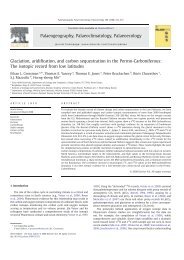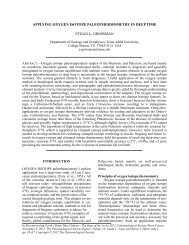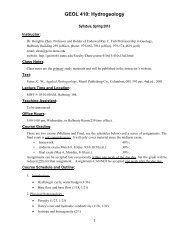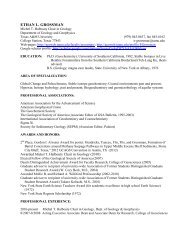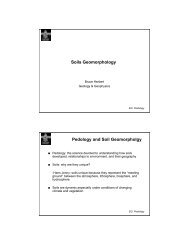An analytical solution for non-Darcian flow in a confined
An analytical solution for non-Darcian flow in a confined
An analytical solution for non-Darcian flow in a confined
Create successful ePaper yourself
Turn your PDF publications into a flip-book with our unique Google optimized e-Paper software.
ADWR 1178 No. of Pages 12, Model 5+<br />
17 July 2007 Disk Used<br />
ARTICLE IN PRESS<br />
10 Z. Wen et al. / Advances <strong>in</strong> Water Resources xxx (2007) xxx–xxx<br />
545 us<strong>in</strong>g distance r = 10 m as an example. It can be found that<br />
546 the drawdown <strong>in</strong> the aquifer is less when n or k are greater<br />
547 at late times; while the opposite is true at early times. This<br />
548 f<strong>in</strong>d<strong>in</strong>g is similar to that of the drawdown <strong>in</strong> the aquifer<br />
549 without consider<strong>in</strong>g wellbore storage.<br />
550 3.3. Drawdowns versus distances at late times<br />
551 To demonstrate the late time behavior of the draw-<br />
552 downs, we compute the drawdowns with different n values<br />
553 at t =10 5 h <strong>for</strong> both Eqs. (14) and (23), the results are<br />
554 shown <strong>in</strong> Fig. 13. The approximate <strong>analytical</strong> <strong>solution</strong><br />
555 Eq. (26) <strong>for</strong> steady-state <strong>flow</strong> is also <strong>in</strong>cluded <strong>in</strong> this figure.<br />
556 The subtle difference <strong>for</strong> the case of n = 1.2 might due to<br />
557 that <strong>flow</strong> is still at unsteady stage even <strong>for</strong> time as large<br />
558 as 10 5 h. When the time is longer than 10 5 h, the numerical<br />
559 <strong>in</strong>version results approach the steady-state <strong>analytical</strong><br />
560 results. This <strong>in</strong>dicates when n is smaller, it will take longer<br />
561 time to approach the steady state.<br />
562 It can also be found that all the drawdown curves are<br />
563 nearly straight with different n values <strong>in</strong> log–log scales. This<br />
564 aga<strong>in</strong> can be expla<strong>in</strong>ed by the approximate <strong>analytical</strong> solu-<br />
565 tion of Eq. (26) <strong>in</strong> which the drawdown is proportional to<br />
566 r 1 n . When plotted <strong>in</strong> log–log scales, the relationship<br />
567 between the drawdown and the distance is a straight l<strong>in</strong>e<br />
568 with a slope of 1 n.<br />
569 4. Summary and conclusions<br />
570 We have developed a method to compute the drawdown<br />
571 of the power law based <strong>non</strong>-<strong>Darcian</strong> <strong>flow</strong> toward a well <strong>in</strong><br />
572 a conf<strong>in</strong>ed aquifer with and without wellbore storage. To<br />
573 use this method, one first has to approximate the <strong>non</strong>-Dar-<br />
574 cian <strong>flow</strong> equation with a l<strong>in</strong>earization equation, then to<br />
575 obta<strong>in</strong> the <strong>solution</strong>s of the l<strong>in</strong>earization equation <strong>in</strong><br />
576 Laplace doma<strong>in</strong>, and f<strong>in</strong>ally to obta<strong>in</strong> the drawdowns by<br />
577 us<strong>in</strong>g a numerical <strong>in</strong>verse Laplace trans<strong>for</strong>m method. The<br />
578 MATALAB based program has been developed to facili-<br />
579 tate the numerical computation. Drawdowns obta<strong>in</strong>ed by<br />
580 our proposed method have been compared with those<br />
581 obta<strong>in</strong>ed by us<strong>in</strong>g the Boltzmann trans<strong>for</strong>m method. We<br />
582 have also analyzed the sensitivity of the drawdowns both<br />
583 <strong>in</strong> the well and <strong>in</strong> the aquifer to a number of parameters<br />
584 such as the power law <strong>in</strong>dex n and the quasi hydraulic con-<br />
585 ductivity k.<br />
586 Several f<strong>in</strong>d<strong>in</strong>gs can be drawn from this study. The<br />
587 drawdown <strong>for</strong> the power law based <strong>non</strong>-<strong>Darcian</strong><br />
p<br />
radial<br />
588 <strong>flow</strong> can not be expressed as a function of g ¼ r= ffiffi t , this<br />
589 means that the drawdown can not be obta<strong>in</strong>ed by directly<br />
590 solv<strong>in</strong>g the <strong>non</strong>-<strong>Darcian</strong> radial <strong>flow</strong> equation with the<br />
591 Boltzmann trans<strong>for</strong>m. The Boltzmann trans<strong>for</strong>m method<br />
592 differs from the l<strong>in</strong>earization method considerably at early<br />
593 and moderate times, but it yields nearly the same results as<br />
594 the l<strong>in</strong>earization method at late times. The results of this<br />
595 new method <strong>for</strong> the special <strong>Darcian</strong> <strong>flow</strong> case (n = 1) agree<br />
596 perfectly with that of the Theis <strong>solution</strong> <strong>for</strong> an <strong>in</strong>f<strong>in</strong>itesi-<br />
597 mally small pump<strong>in</strong>g well, and with that of the Papadopu-<br />
los and Cooper <strong>solution</strong> [21] <strong>for</strong> a f<strong>in</strong>ite-diameter pump<strong>in</strong>g<br />
well. If the power <strong>in</strong>dex n and the quasi hydraulic conductivity<br />
k get larger, drawdowns at early times will get<br />
greater; whereas drawdowns at late times will become less,<br />
regardless of the wellbore storage. When n is larger, <strong>flow</strong><br />
approaches steady state earlier. <strong>An</strong>d the drawdown is<br />
approximately proportional to r 1 n at steady state. The<br />
late time drawdown is a superposition of the steady-state<br />
<strong>solution</strong> and a negative time-dependent term that is proportional<br />
to t (1 n)/(3 n) .<br />
5. Uncited references<br />
[22,23,39]. Q1 609<br />
Acknowledgements<br />
This research was partly supported by the National Natural<br />
Science Foundation of Ch<strong>in</strong>a (Grant Numbers<br />
50428907 and 50479011) and the Program <strong>for</strong> New Century<br />
Excellent Talents <strong>in</strong> University (Grant Number<br />
NCET-05-0125). We would like to thank Dr. Yu-Shu Wu<br />
<strong>for</strong> br<strong>in</strong>g<strong>in</strong>g us attention of the study on <strong>non</strong>-Newtonian<br />
<strong>flow</strong>. The constructive comments from five a<strong>non</strong>ymous<br />
reviewers and the Editor are also gratefully acknowledged,<br />
which help us improve the quality of the manuscript.<br />
Appendix A. Derivation of the <strong>analytical</strong> <strong>solution</strong>s at steady<br />
state and late times<br />
UNCORRECTED PROOF<br />
598<br />
599<br />
600<br />
601<br />
602<br />
603<br />
604<br />
605<br />
606<br />
607<br />
608<br />
610<br />
611<br />
612<br />
613<br />
614<br />
615<br />
616<br />
617<br />
618<br />
619<br />
620<br />
621<br />
For steady-state <strong>flow</strong>, one has os ¼ 0. Then Eq. (9) can 622<br />
ot<br />
be changed to<br />
623<br />
o 2 s<br />
or þ n os<br />
2 r or ¼ 0; ðA1Þ 625<br />
or,<br />
626<br />
<br />
o<br />
r n os <br />
¼ 0:<br />
ðA2Þ<br />
or or<br />
628<br />
Then one has<br />
629<br />
630<br />
r n os<br />
or ¼ C os<br />
0; or<br />
or ¼ C 0<br />
r ; ðA3Þ n 632<br />
where C 0 is a constant, which can be obta<strong>in</strong>ed by the 633<br />
boundary condition Eq. (8). Substitut<strong>in</strong>g Eq. (A3) to Eq. 634<br />
(8), one has<br />
635<br />
<br />
Q n<br />
2pm<br />
C 0 ¼<br />
k<br />
: ðA4Þ 637<br />
For steady-state <strong>flow</strong>, the drawdown at a sufficiently far 638<br />
distance R from the well will be essentially be zero, where 639<br />
R is often called the radius of <strong>in</strong>fluence of the well. There- 640<br />
<strong>for</strong>e, <strong>in</strong>tegrat<strong>in</strong>g Eq. (A3) leads to the f<strong>in</strong>al steady-state 641<br />
<strong>solution</strong> as 642<br />
643<br />
n <br />
Q 1 1 1<br />
sðrÞ ¼<br />
; r<br />
2pm kðn 1Þ r n 1 R n 1 w 6 r 6 R<br />
ðA5Þ 645<br />
Please cite this article <strong>in</strong> press as: Wen Z et al., <strong>An</strong> <strong>analytical</strong> <strong>solution</strong> <strong>for</strong> <strong>non</strong>-<strong>Darcian</strong> <strong>flow</strong> <strong>in</strong> a conf<strong>in</strong>ed ..., Adv Water Resour<br />
(2007), doi:10.1016/j.advwatres.2007.06.002



